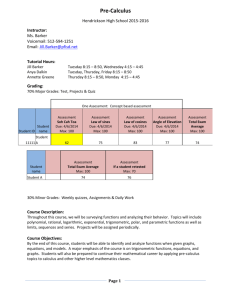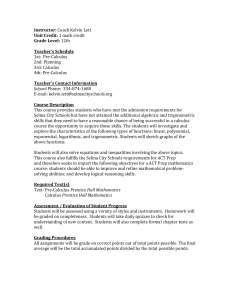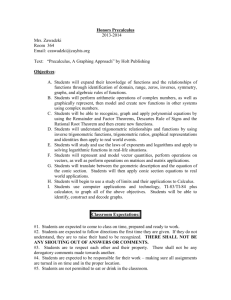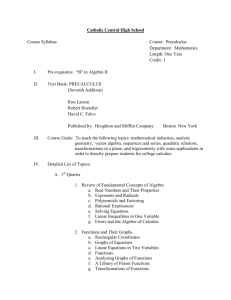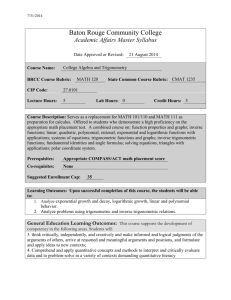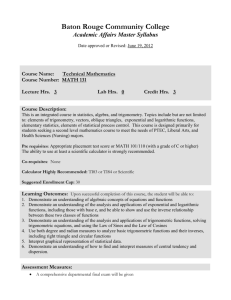PreCalAP
advertisement
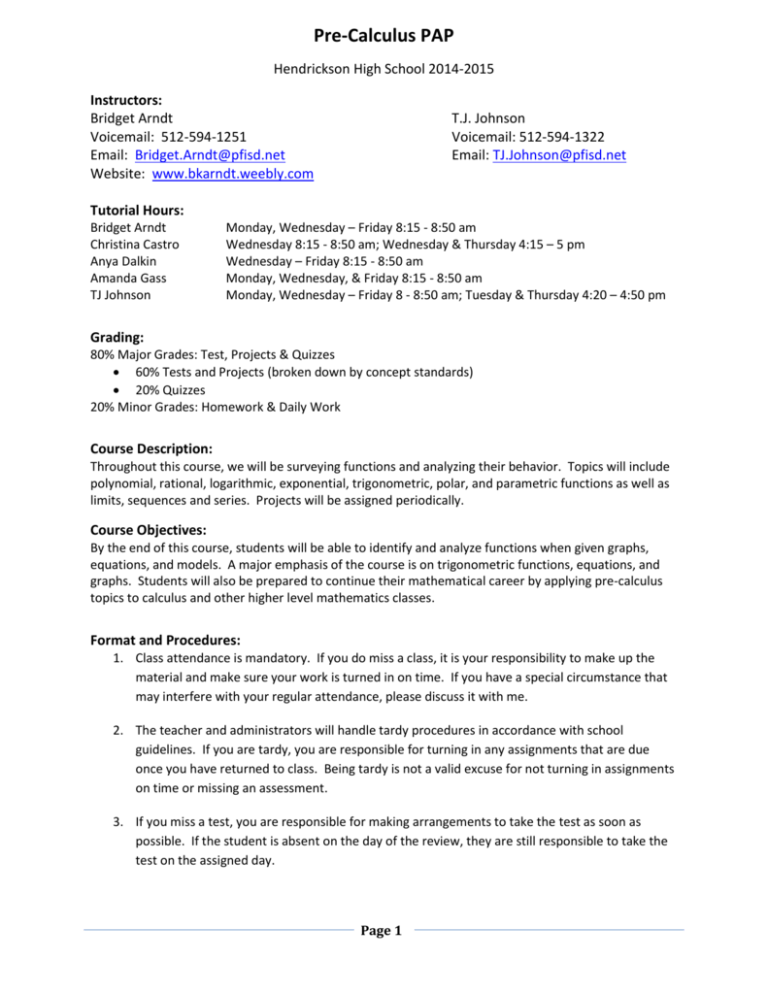
Pre-Calculus PAP Hendrickson High School 2014-2015 Instructors: Bridget Arndt Voicemail: 512-594-1251 Email: Bridget.Arndt@pfisd.net Website: www.bkarndt.weebly.com T.J. Johnson Voicemail: 512-594-1322 Email: TJ.Johnson@pfisd.net Tutorial Hours: Bridget Arndt Christina Castro Anya Dalkin Amanda Gass TJ Johnson Monday, Wednesday – Friday 8:15 - 8:50 am Wednesday 8:15 - 8:50 am; Wednesday & Thursday 4:15 – 5 pm Wednesday – Friday 8:15 - 8:50 am Monday, Wednesday, & Friday 8:15 - 8:50 am Monday, Wednesday – Friday 8 - 8:50 am; Tuesday & Thursday 4:20 – 4:50 pm Grading: 80% Major Grades: Test, Projects & Quizzes 60% Tests and Projects (broken down by concept standards) 20% Quizzes 20% Minor Grades: Homework & Daily Work Course Description: Throughout this course, we will be surveying functions and analyzing their behavior. Topics will include polynomial, rational, logarithmic, exponential, trigonometric, polar, and parametric functions as well as limits, sequences and series. Projects will be assigned periodically. Course Objectives: By the end of this course, students will be able to identify and analyze functions when given graphs, equations, and models. A major emphasis of the course is on trigonometric functions, equations, and graphs. Students will also be prepared to continue their mathematical career by applying pre-calculus topics to calculus and other higher level mathematics classes. Format and Procedures: 1. Class attendance is mandatory. If you do miss a class, it is your responsibility to make up the material and make sure your work is turned in on time. If you have a special circumstance that may interfere with your regular attendance, please discuss it with me. 2. The teacher and administrators will handle tardy procedures in accordance with school guidelines. If you are tardy, you are responsible for turning in any assignments that are due once you have returned to class. Being tardy is not a valid excuse for not turning in assignments on time or missing an assessment. 3. If you miss a test, you are responsible for making arrangements to take the test as soon as possible. If the student is absent on the day of the review, they are still responsible to take the test on the assigned day. Page 1 4. New this year, Pre-Calculus assessments will be graded by concept standards. This means that one assessment will be broken down by each concept in order to demonstrate mastery of individual standards. Students will be allowed to correct standards that are not mastered without having to correct the entire assessment and then re-test only the missed standards. 5. Students scoring below “70” on a concept standard will be expected to re-test the failed concept standard after completing assessment corrections. The higher grade with a maximum of “70,” shall be recorded. Redoing a major assessment should be completed within 5 days of the teacher returning the assessment. 6. If you are absent the day a project is due, it is due the day you return to class. 7. Quizzes: Students scoring below “70” on a quiz shall be allowed to redo the quiz after completing quiz corrections. The higher grade with a maximum of “70,” shall be recorded. 8. Homework Policy: Homework will be assigned daily. Students may turn in late assignments within the three week progress report period for a maximum grade of a 70. 9. Conduct: a. Be on time and prepared for class to begin. b. Be respectful to yourself and others. c. Be responsible for your actions and lessons. Course Requirements: 1. Requested Supplies: Graphing Calculator (highly encouraged), 4 pack AAA batteries, 4-pack expo dry erase markers multi-color. 2. Required Supplies: mechanical pencils, paper, binder and spiral / composition book. 3. Required Text: Larson, Ron, et. al., Pre-Calculus with Limits. Boston, MA: Houghton Mifflin Company, 2007. Academic Integrity: Each student in this course is expected to abide by the Pflugerville ISD Code of Conduct and Student Handbook with regards to Academic Integrity. Any work submitted by a student in this course for academic credit will be the student’s own work unless otherwise specifically directed by the teacher. Page 2 Pre-Calculus PAP Hendrickson High School 2014-2015 Class Contract I have read and agree to the terms of the class syllabus. I will give 100% effort in this class – including class work, homework, and any other activities the class is asked to do. I will respect each classmate by putting people up rather than putting people down, and listening carefully to everyone. I will choose not to bully anyone in any way, such as yelling, pushing, touching, judging, or annoying. Whatever is said in this room will stay in this room, so that this is a safe place to make mistakes and learn from them. I realize that I will be challenged in this class and it is my choice to accept the challenge. I acknowledge and will strive to meet the class expectations, and I will follow all class and school rules. I acknowledge and will accept the consequences if I fail to meet the class expectations or class and school rules. _____________________________________________ Student Printed Name ____________________________________ Student’s Best contact (phone or email) _____________________________________________ Student Signature ____________________________________ Date PARENTS: I have read and understand the course requirements and procedures for Pre-AP Algebra 2. To acknowledge receipt of this information, please complete and have your student return this form to his/her teacher. Also, email your student’s teacher with your student’s full name and class period in the subject line, your full name in the body of the email and have the student return it to their teacher by Friday, August 29th. _____________________________________________ Parent/Guardian Signature Parent/Guardian Printed Name: Parent/Guardian Phone Contact ____________________________________ Date _________________________________________________________ Home: ______________________________________ Work: ______________________________________ Cell: _______________________________________ Email: ______________________________________ Page 3 Pre-Calculus Curriculum at a Glance Topic Polynomial, Linear, and Square Root Functions Polynomial and Rational Functions Exponential and logarithmic functions Begin Trigonometric Functions Trigonometric functions Trigonometric functions cont. Vectors Conics Polar and Parametrics (with some conics) Sequences and series Limits Conceptual Understanding All functions have a parent. Even and odd functions involve symmetry. Functions can be represented by graphs, tables and symbols. Transformations involve vertical and horizontal shifting, stretching and compression. The number of roots of a polynomial function is related to its degree. Some functions require restrictions on their domain. A function can be continuous at some points and not at others. A function is generally said to be discontinuous if there is any point of discontinuity. When determining domain and range of a rational function, restrictions (causing such things as vertical asymptotes and holes) may need to be considered. Patterns in end behavior of rational functions can be used to quickly sketch graphs of functions or to quickly identify characteristics of rational functions from graphs. Rational functions may have a limit and may not. Exponential and logarithmic functions are inverses. Exponential and logarithmic functions exhibit asymptotic behavior. Properties of exponents and logarithms are related and can be used to simplify expressions and solve equations. The “Unit Circle” is circle with radius of one unit that is a tool used in understanding trigonometric ratios of angles found in right triangles. Angle measures can be expressed in degrees or in radians. Pythagorean Theorem and trigonometric ratios can be used to find distances/lengths of the sides of right triangles, and trig ratios can also be used to find angle measures of a triangle. Trigonometric functions have unique and recognizable graphs. Trigonometric functions can be used to model real world situations such as amplitude and frequency of sound waves and the movement of pendulums and Ferris wheels. Trigonometric functions are periodic. Trigonometric identities can be used to simplify expressions and solve equations Vectors are used to model situations involving two or more quantities. Vectors can be represented multiple ways. Conics model many real world situations. A parametric set of equations determines when an object will be at a specific location. Polar equations simplify conic equations. Conics model many real world situations. A parametric set of equations determines when an object will be at a specific location. Polar equations simplify conic equations. Sequences are patterns that relate the term number to the term itself, or relate one term to the next. Series are sums of sequences. Some series converge and some diverge. The limit of a function can be determined by calculating the value of a function for x-values that are very close to a given x-value. There are a variety of techniques such as dividing out, rationalizing, and graphical techniques to evaluate and approximate limits. Limits can also be found by studying the behavior of different parts of a function as x increases or decreases without bound. Limits can be used to find expected values of functions. Page 4
